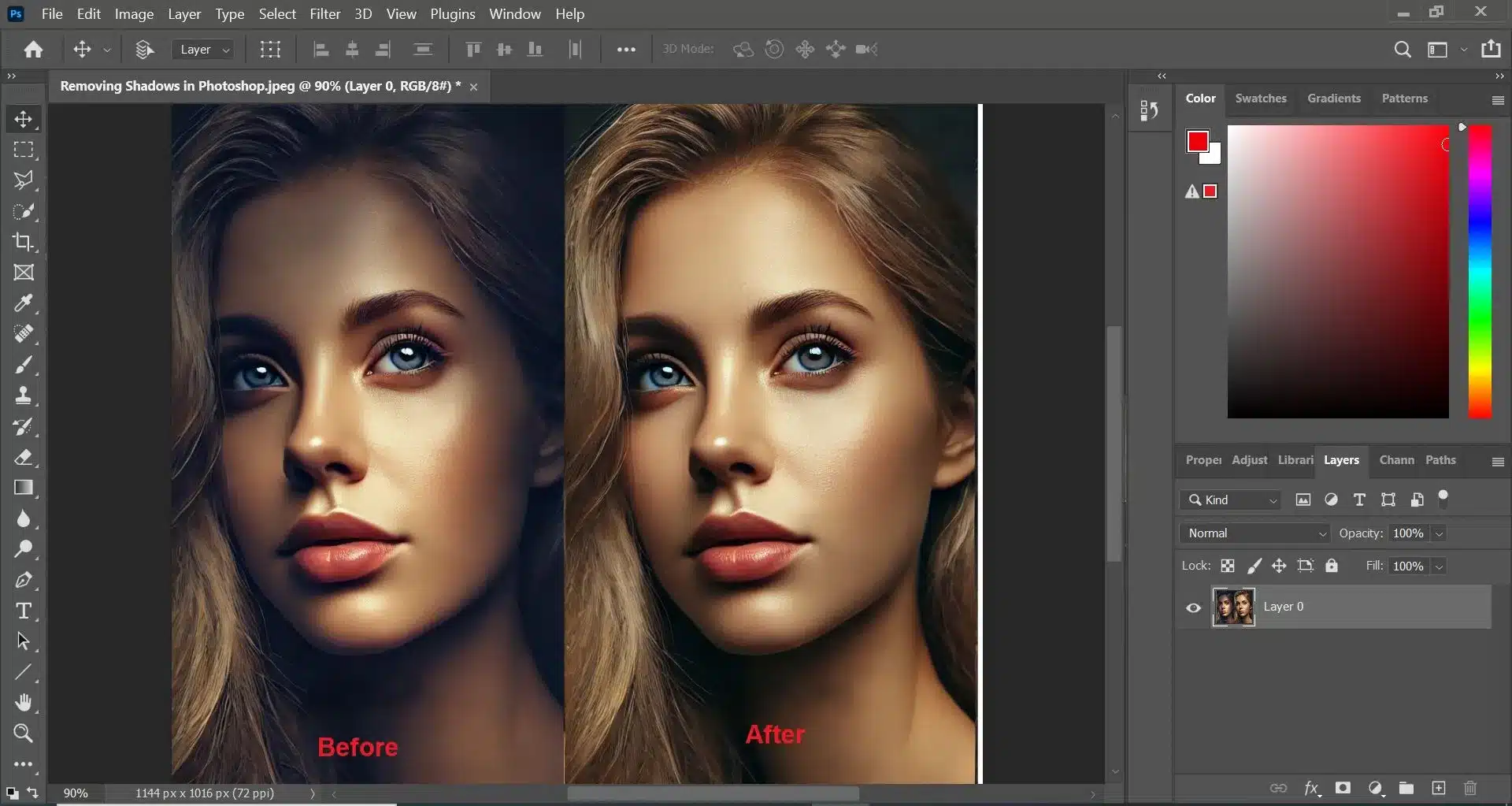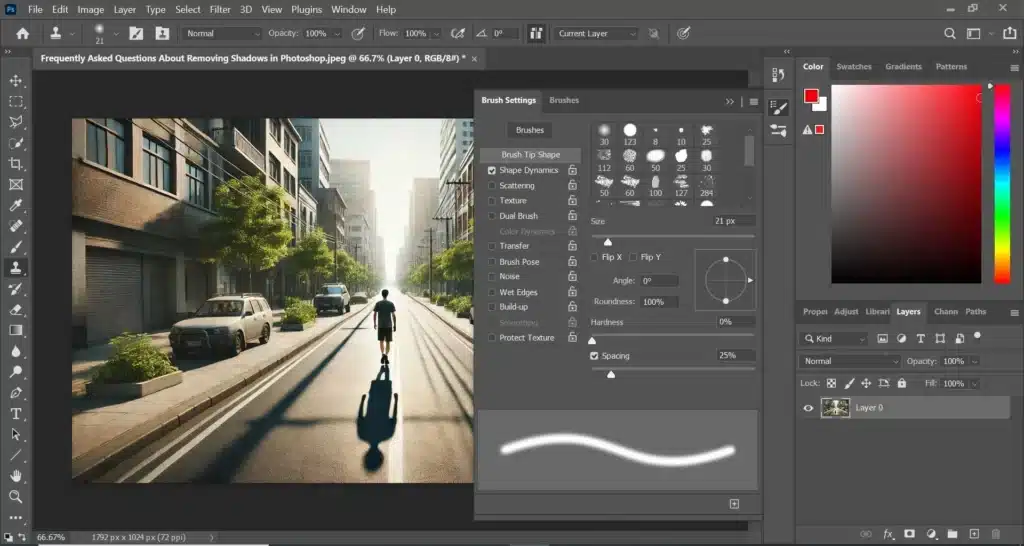
Introduction to Removing Shadows in Photoshop
Shadows can add depth and dimension to your photos, but sometimes they can also create unwanted distractions. Removing shadows in Photoshop is a crucial skill for photographers and designers looking to achieve perfect, distraction-free images. This Photoshop shadow removal tutorial will guide you through effective techniques for fixing shadows in Photoshop, ensuring your photos look professional and polished. For instance, consider a portrait taken outdoors where a tree’s shadow falls across the subject’s face.
In this tutorial, we’ll explore various methods, from basic to advanced, to help you master shadow removal. Whether you’re dealing with harsh midday outlines or subtle lighting inconsistencies, understanding how to use Content-Aware Fill and adjustment layers will be invaluable. We’ll also cover real-life scenarios and practical examples to make the learning process engaging and applicable.
Table of Contents
Why Shadow Removal is Important

Adding shadows can often detract from the quality and professionalism of your photos. Removing shadows in Photoshop ensures that your images look clean and focused. This process is essential for various reasons, which we will explore in the sections below.
1. Enhancing Image Clarity
When shadows fall on critical parts of a photo, they can obscure important details and make the image appear cluttered. For example, in product photography, shadows can hide essential features, leading to a less effective representation of the product. After this, you ensure that every detail is visible, which is crucial for marketing and advertising purposes.
2. Improving Visual Appeal
Photos with harsh shadows can appear unbalanced and less visually appealing. This is particularly important in portrait photography, where silhouette can create unflattering lines on a subject’s face. Removing shadows in Photoshop helps in achieving a more balanced and aesthetically pleasing photography lightening, making it more appealing to viewers.
3. Maintaining Professional Standards
In professional photography, maintaining high standards is critical. Outlines can make an image look amateurish and unpolished. By mastering shadow removal, photographers can ensure their work meets the professional quality expected by clients and audiences. This skill is particularly important in fields like fashion photography, where the final image’s quality directly impacts its success.
4. Enhancing Focus on Key Elements
Shadows can distract viewers from the main subject of a photo. In architectural photography, for example, shadows can draw attention away from the building’s design and details. By eliminating shadows, photographers can ensure that the viewer’s focus remains on the intended subject, enhancing the overall impact of the photograph.
5. Ensuring Consistency in Photo Collections
For photographers who work on projects requiring a series of images, such as catalogs or portfolios, consistency is key. Shadows can vary from photo to photo, leading to a disjointed and unprofessional look. Fixing shadows in Photoshop ensures a consistent lighting and quality across all images, providing a cohesive and professional presentation.
Removing Shadows in Photoshop: Step by Step Guide
Fixing shadows in Photoshop from your photos involves several options and techniques. Here’s a detailed, step-by-step guide to help you achieve the best results. This section will cover various methods, including using the Content-Aware Fill and adjustments layers.
Step 1: Duplicate the Background Layer
Before starting any editing, it’s crucial to duplicate your background layer. This ensures that your original photograph remains intact and provides a fallback in case of mistakes.
1. Open your image in Photoshop.
2. Duplicate the layer by right-clicking on this layer in the Layers panel and selecting “Duplicate Layer,” or use the shortcut Ctrl + J (Windows) or Command + J (Mac).
3. Rename the duplicated layer (optional) to keep your workspace organized.
Step 2: Use the Content-Aware Fill
The Content-Aware Fill is perfect for eliminating smaller, isolated shadows. It uses surrounding pixels to intelligently fill in the selected area.
1. Select the shadow using a selection tool such as the Lasso or the Marquee. The smart fill option is also useful for selections.
2. Go to the Edit menu and choose “Content-Aware Fill.”
3. In the Content-Aware Fill workspace, you can adjust the sampling area. Use the brush to include or exclude parts that Photoshop will use to generate the fill.
4. Preview the changes in real-time. Adjust settings such as Color Adaptation, Rotation Adaptation, and Scale to improve the fill result.
5. Once satisfied, click OK. The selected shadow should be replaced with a seamless blend of surrounding pixels.
Step 3: Using the Patch Tool
For more controlled shadow removal, it allows you to replace a selected area with pixels from another part of the image.
1. Select the Patch Tool from the toolbar.
2. In the options bar, ensure Content-Aware is selected from the dropdown menu.
3. Draw a selection around the shadow you want to remove.
4. Drag the selection to an area that closely matches the backscene around the shadow. The software will use this point to replace the shadow.
5. Adjust the Structure and Color settings if needed to refine the blend.
Step 4: Lightening Shadows with Adjustments Layers
Sometimes, completely eliminating a shadow is unnecessary. Instead, you can lighten it to make it less noticeable while retaining some depth in the photograph.
1. Select the shadow using the Quick Selection Tool or the Lasso.
2. Create a new Adjustment Layer by clicking on the Adjustment Layer icon in the Layers panel and choosing “Levels” or “Curves.”
3. In the Properties panel, adjust the sliders to lighten the selected shadow. Moving the middle and right sliders to the left in the Levels adjustment can help reduce the shadow’s darkness.
4. Use the Layer Mask to refine them, ensuring that only the shadow portion is affected and not the entire photograph.
Step 5: Fine-Tuning with the Clone Stamp
For intricate shadow parts, the Clone Stamp Tool offers precise control by allowing you to paint over fixing shadows in photoshop using pixel information from other parts of the image.
1. Select the Clone Stamp from the toolbar.
2. Choose a soft brush and set the opacity to around 50% for a more natural blend.
3. Alt-click (Windows) or Option-click (Mac) on the portion you want to sample from.
4. Paint over the shadow, sampling new points frequently to ensure a seamless blend. This method requires patience but can yield excellent results.
Step 6: Final Touches and Blending
After removing or lightening the shadows, it’s important to use different blending modes on the edited areas to ensure a natural look.
1. Use the Healing Brush Tool to smooth out any harsh transitions.
2. Apply a Gaussian Blur to the edited portion if needed, to match the image’s overall softness.
3. Zoom out and review the entire photograph to check for consistency and make any final improvements.
By following these steps, you can master the art of removing shadows in Photoshop, enhancing the clarity and appeal of your photos. you can learn various actions, such as using Content-Aware Fill, and copy these techniques to your workflow for better results.
Advanced Techniques for Eliminating Shadows
To achieve the highest level of precision and realism in your edited images, mastering advanced techniques is essential. These methods involve using sophisticated features, ensuring that the final result is seamless and professional. This section will cover advanced cloning, gradient mapping, frequency separation, and luminosity masking techniques.
| Technique | Description | Use Cases | Steps Overview |
|---|---|---|---|
| Advanced Cloning | Detailed pixel replacement to blend edits flawlessly | Intricate patterns, facial retouching | Clone Stamp, Healing Brush, careful pixel matching |
| Gradient Mapping | Adjusting color gradients to match lighting conditions | Correcting color mismatches, enhancing highlights | Create gradient map, apply blend modes, adjust opacity |
| Frequency Separation | Separating texture and color for fine control over edits | High-end retouching, skin smoothing | Duplicate layers, apply blur, use High Pass filter |
| Luminosity Masking | Targeting specific light levels for precise edits | Enhancing contrast, selective light adapting | Create luminosity masks, blend carefully |
By utilizing these advanced techniques, you can elevate your image editing skills, ensuring your edits are not only effective but also visually impeccable.
Common Mistakes to Avoid When Removing Shadows
When working to improve your images, there are several common pitfalls that can detract from the final result. Understanding and avoiding these mistakes will ensure that your edits look professional and seamless.
Overusing the Clone Tools
One of the most frequent errors is relying too heavily on the clone function. While it’s useful for certain tasks, excessive use can result in a repetitive pattern that makes the edited portions obvious. It’s important to vary your source points frequently to maintain a natural look.
Ignoring Color and Texture Matching
Another common mistake is not paying enough attention to matching colors and textures. When you edit a section of your photograph, it’s crucial that the new point blends perfectly with the surrounding pixels. Failing to do this can create noticeable discrepancies that draw attention to the edited parts.
Pro Tip: Learn different text effects to make this process even easier.
Neglecting Layer Management
Proper layer management is essential for non-destructive editing. Many beginners forget to work on duplicate layers or use layer masks, leading to irreversible changes. Always duplicate your original layer and use masks to refine your edits without affecting the base image.
Skipping the Refinement Process
Rushing through the editing process without taking the time to refine your work can leave visible artifacts and inconsistencies. Zoom in to check your edits closely and use soft brushes and low-opacity settings to blend edges smoothly.
Inconsistent Lighting Adjustments
When adjusting lighting, it’s important to maintain consistency throughout the image. Inconsistent lighting changes can make the edited areas stand out. Use layers to control brightness and contrast in a way that harmonizes with the entire image.
Relying Solely on Automated Utilities
While automated functions like Content-Aware Fill are powerful, relying solely on them can lead to unsatisfactory results. They might not always interpret complex parts correctly. Be prepared to manually refine to achieve the best outcome.

Frequently Asked Questions About Removing Shadows in Photoshop
How do I fix shadow in Photoshop on an image?
To remove a shadow from an image in Adobe Photoshop, start by duplicating the background layer to preserve the original. Use the Content-Aware Fill feature to fill in the shadowed region with surrounding pixels. You can also employ the Patch method to replace the shadowed region with a similar part of the image, ensuring a seamless blend.
How do I get rid of unwanted shadows?
Fixing of shadows in Photoshop involves using the Patch and Clone Stamp methods to cover the shadowed part with pixels from a similar source. Additionally, adjusting the brightness and contrast levels using adjustment layers can help minimize the visibility of unwanted outlines, making the image look more natural and balanced.
How do I extract shadows in Photoshop?
To extract shadows, you can use techniques like gradient mapping and luminosity masking. Start by creating a new layer and applying a gradient map to match the lighting conditions. Use luminosity masks to target specific light levels, making precise adapting to enhance or reduce the shadows as needed.
How do I fix dark shadows in Photoshop?
Fixing dark shadows involves using the Dodge to lighten specific parts of the image. Begin by creating a new layer and applying a Curves or Levels adjustment to increase the brightness. The Dodge can then be used to selectively brighten the shadowed regions, ensuring the adjustments blend seamlessly with the rest of the image.
Conclusion
Removing shadows in Photoshop is an essential skill for any photographer or designer aiming to produce high-quality, professional images. I remember working on a client’s outdoor portrait session where a shadow from a nearby tree fell across their face, detracting from the overall composition. Using the techniques outlined in this guide, I was able to effectively remove the shadow, resulting in a polished and visually appealing image that the client loved.
If you want to master these skills and more, I encourage you to follow our comprehensive courses where you can learn the intricacies of Photoshop and Lightroom. Our Photoshop Course offers in-depth tutorials and hands-on projects, while the Lightroom Course provides advanced editing techniques to enhance your photography. Start your journey to becoming a photo editing expert today!
Have a nice photoshoot!
Learn more about Photo Editing with Lightroom and Photoshop:

















